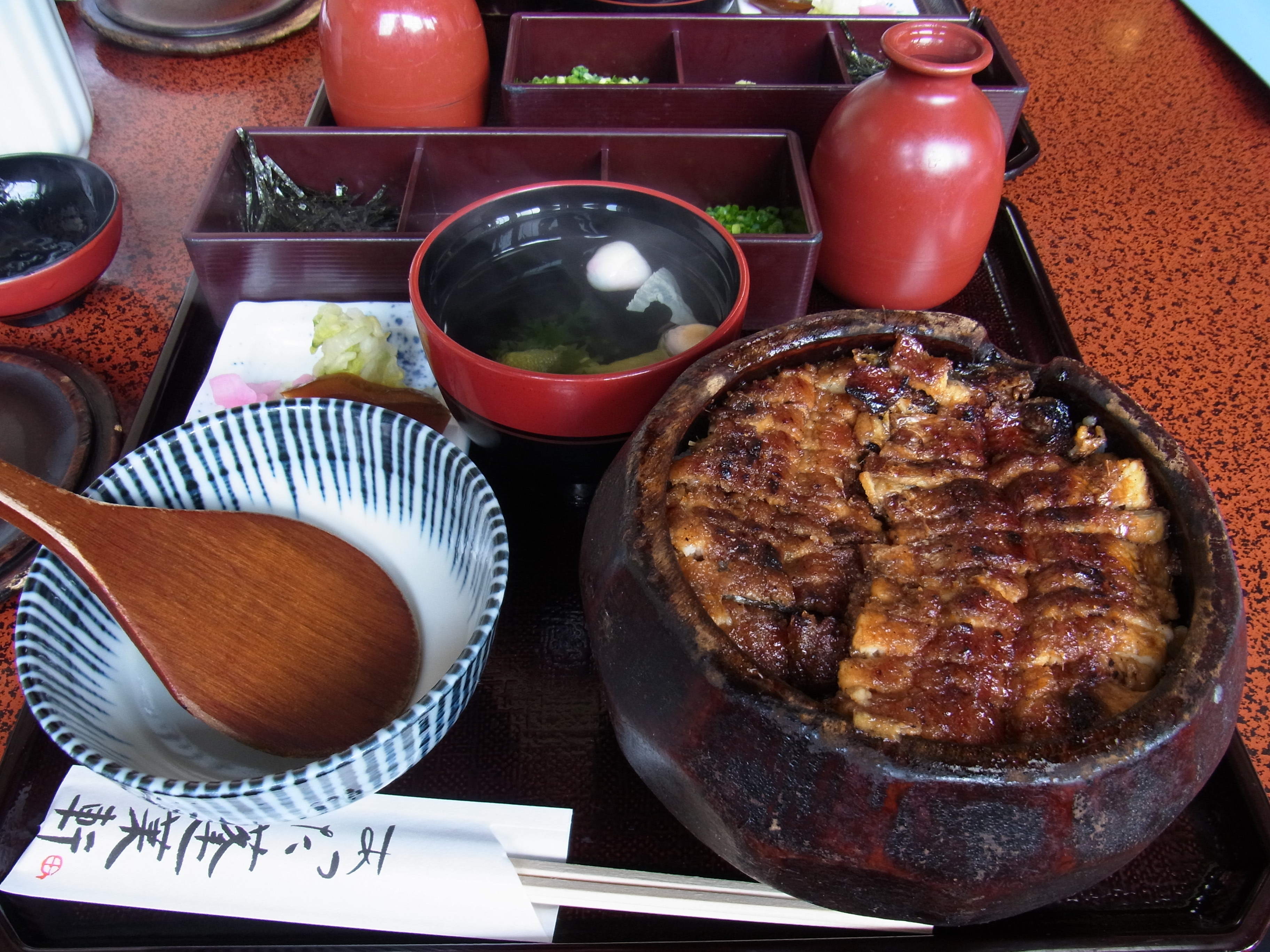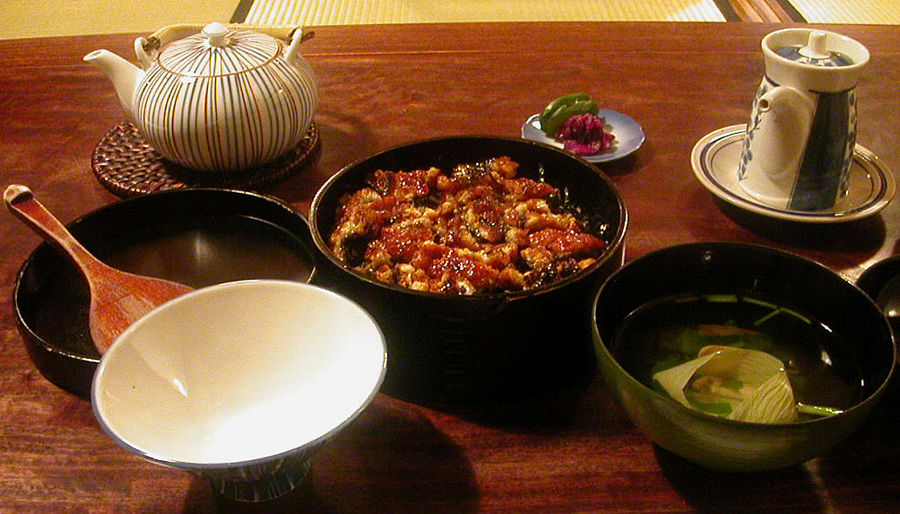Hitsumabushi on:
[Wikipedia]
[Google]
[Amazon]
''Hitsumabushi'' is a local dish of Japan, consisting of thinly sliced ''
unagi
is the Japanese word for freshwater eel, particularly the Japanese eel, . Unagi is a common ingredient in Japanese cooking, often as '' kabayaki''. It is not to be confused with saltwater eel, which is known as '' anago'' in Japanese.
In J ...
'' (eel) grilled in ''kabayaki
is a preparation of fish, especially '' unagi'' eel,, vol. 7,"kabayaki" by describes it as being used principally or almost always for ''unagi'' (「もっぱら鰻」) where the fish is split down the back the Japanese dictionary says ''kab ...
'' style on rice. ''Hitsumabushi'' became common in the 1950s, when farm-raised eel became widely available.
How to Eat
The grilled eel and rice dish can be eaten three ways. Typically, the first serving is eaten as is, just the eel and rice; the second serving is eaten with toppings such as '' negi'', ''wasabi
Wasabi (Japanese language, Japanese: , , or , ) or Japanese horseradish (''Eutrema japonicum'' syn. ''Wasabia japonica'') is a plant of the family Brassicaceae, which also includes horseradish and Mustard plant, mustard in other genus, genera. ...
'', ''nori
Nori is a dried edible seaweed used in Japanese cuisine, usually made from species of the red algae genus ''Pyropia'', including ''P. yezoensis'' and ''Pyropia tenera, P. tenera''. It has a strong and distinctive flavor, and is generally made in ...
'', and/or '' mitsuba''; the third serving is eaten with ''dashi
is a family of stocks used in Japanese cuisine. ''Dashi'' forms the base for miso soup, clear broth soup, noodle broth soup, and many simmering liquids to accentuate the savory flavor known as umami. ''Dashi'' is also mixed into the flour b ...
'' or green tea poured over the eel and rice, in addition to the other toppings, to make ''chazuke
''Chazuke'' ( 茶漬け, ちゃづけ) or ''ochazuke'' ( お 茶 漬 け, from ( o)''cha'' ' tea' + ''tsuke'' 'submerge') is a simple Japanese dish made by pouring green tea,

 The origins of this cuisine and when it came to be called ''Hitsumabushi'' are not exactly known. The prevailing theory is that it originated in a ''
The origins of this cuisine and when it came to be called ''Hitsumabushi'' are not exactly known. The prevailing theory is that it originated in a ''
History

 The origins of this cuisine and when it came to be called ''Hitsumabushi'' are not exactly known. The prevailing theory is that it originated in a ''
The origins of this cuisine and when it came to be called ''Hitsumabushi'' are not exactly known. The prevailing theory is that it originated in a ''Ryōtei
A is a type of traditional Japanese restaurant. Traditionally, only accept new customers by referral and feature entertainment by geisha, but in modern times this is not always the case. are typically places where high-level business or poli ...
'' restaurant in Nagoya, but some say it originated in Tsu City, Mie Prefecture. Others believe that it originated in the Kansai region.
Theory that originated in Nagoya
One such restaurant that claims to be the originator is "Atsuta Houraiken" inAtsuta-ku, Nagoya
is one of the 16 Wards of Japan, wards of the city of Nagoya in Aichi Prefecture, Japan. As of 1 October 2019, the ward had an estimated population of 66,318 and a population density of 8,088 persons per km2. The total area was 8.20 km2.
...
, or ."Iba sho" in Naka-ku, Nagoya
is one of the 16 Wards of Japan, wards of the city of Nagoya in Aichi Prefecture, Japan. As of 1 October 2019, the ward has an estimated population of 90,918 and a population density of 9,693 persons per km2. The total area is 9.38 km2.
G ...
.
"Atsuta Houraiken" dates the establishment of Hitsumabushi to the Meiji period
The was an era of Japanese history that extended from October 23, 1868, to July 30, 1912. The Meiji era was the first half of the Empire of Japan, when the Japanese people moved from being an isolated feudal society at risk of colonizatio ...
. "Atsuta Houraiken" served ''unagi
is the Japanese word for freshwater eel, particularly the Japanese eel, . Unagi is a common ingredient in Japanese cooking, often as '' kabayaki''. It is not to be confused with saltwater eel, which is known as '' anago'' in Japanese.
In J ...
'' rice in pottery
Pottery is the process and the products of forming vessels and other objects with clay and other raw materials, which are fired at high temperatures to give them a hard and durable form. The place where such wares are made by a ''potter'' is al ...
bowls at that time, but since there were many deliveries and delivery staff often broke empty bowls when they return. Therefore, the bowls were placed in large, break-proof wooden tubs. The restaurant also added a plate for the number of people to share the bowl with. In 1985, "Atsuta Houraiken" applied to register ''Hitsumabushi'' as a trademark with the Japan Patent Office
The is a Japanese governmental agency in charge of industrial property right affairs, under the Ministry of Economy, Trade and Industry. The Japan Patent Office is located in Kasumigaseki, Chiyoda, Tokyo and is one of the world's largest pa ...
, and it was registered in 1987 (see below).
"Ibasyo" states that ''hitsumabushi'' was established in the Taishō era
The was a period in the history of Japan dating from 30 July 1912 to 25 December 1926, coinciding with the reign of Emperor Taishō. The new emperor was a sickly man, which prompted the shift in political power from the old oligarchic group ...
. A description of ''hitsumabushi'' can be found in the "Ibasho" section of the "Nagoya Mikaku Map" published by Sogensha in 1964.
Theory that originated in Tsu city
According to a restaurant founded in 1875 inTsu, Mie
is the capital city of Mie Prefecture, Japan. , the city had an estimated population of 274,879 in 127,273 households and a population density of 390 persons per km2. The total area of the city is . Although the second largest city in the ...
, before eel farming began, they used natural eels, which were of uneven size. The thicker ones were too hard to serve to customers. It would have been a waste to dispose of them, so they were grilled and chopped into small pieces for the employees' meals. The smell of the fish would linger if it was grilled too quickly, so it is assumed that they added condiments and made it into chazuke (rice with green tea). In other words, it was something they had no choice but to eat at that time. The owner of the restaurant heard that it was offered in Nagoya and started offering it as a menu item around 1975, and several restaurants in Tsu also started offering it after receiving inquiries about ''hitsumabushi''.
Other
Some believe it was before theMeiji era
The was an Japanese era name, era of History of Japan, Japanese history that extended from October 23, 1868, to July 30, 1912. The Meiji era was the first half of the Empire of Japan, when the Japanese people moved from being an isolated feu ...
.
A book published in Tokyo in 1926, "Spring, Summer, Autumn, Winter Daily Dishes," does not mention the word ''hitsumabushi'', but describes a dish in which grilled eel is cut into 2-3 '' bu'' (3–9 mm), placed on freshly cooked rice, and stirred with a liquid of soy sauce, mirin and coarse sugar boiled down.
Some people attribute it to the period of food shortages after World War II
World War II or the Second World War (1 September 1939 – 2 September 1945) was a World war, global conflict between two coalitions: the Allies of World War II, Allies and the Axis powers. World War II by country, Nearly all of the wo ...
. The author of the article, however, later changed the term to "apparently prewar period".
Naming
Several hypotheses have been raised as to the origin of the name ''hitsumabushi''. *The theory that it is because it is spread (''mabusu'' in Japanese) on rice in a tub (''hitsu'' in Japanese.) *According to the ''Morisada Mankou'' (守貞漫稿) written in the 19th century, eel bowls were called ''mabushi'' in theKansai region
The or the lies in the southern-central region of Japan's main island Honshū. The region includes the prefectures of Nara, Wakayama, Kyoto, Osaka, Hyōgo and Shiga, often also Mie, sometimes Fukui, Tokushima and Tottori. The metropol ...
. If this is the origin of the word ''hitsu-mabushi'', then it has been in use since the 19 century. However, there is a view that this is coincidental and has nothing to do with ''hitsumabushi''.
Trademark
''Hitsumabushi'' is a registered trademark of Nagoya-based Houraiken Corporation, filed in 1985 and registered in 1987. However, this does not mean that Houraiken is the originator of ''hitsumabushi''. In addition, this was registered as a product, and "offering food and drink" was not subject to registration at the time of application. After this category became eligible for registration, Houraiken applied for a trademark for "offering food and drink," but theJapan Patent Office
The is a Japanese governmental agency in charge of industrial property right affairs, under the Ministry of Economy, Trade and Industry. The Japan Patent Office is located in Kasumigaseki, Chiyoda, Tokyo and is one of the world's largest pa ...
rejected the application, stating that "most eel restaurants in Nagoya add this to their menus, and it is known throughout the country as a Nagoya specialty."
References
{{Reflist, refs= {{Cite web, url=http://www.houraiken.com/history.html, title=あつた蓬莱軒の歴史, author=あつた蓬莱, access-date=2023-12-17 {{Cite web, url=http://www.ibashou.jp/hitumabushi.html, title=ひつまぶし, author=錦三丁目 いば昇, access-date=2023-12-17 {{Cite news, title=[面白ばなし]うなぎの櫃まぶし/愛知, author=呉智英, date=1998-06-25, work=Mainichi Shimbun
The is one of the major newspapers in Japan, published by
In addition to the ''Mainichi Shimbun'', which is printed twice a day in several local editions, Mainichi also operates an English-language news website called , and publishes a bilin ...
(静岡版)
{{Cite book, title=真実の「名古屋論」 トンデモ名古屋論を撃つ, author=呉智英, date=2012-05-22, publisher=樹林舎, isbn=978-4931388666, page=99
{{Cite book, title=名古屋味覚地図, editor=創元社編集部, year=1964, publisher=創元社
{{Cite news, title=(ナゴヤ 虚と実:7)味噌カツ丼 浅草の料理人、戦後考案, author=呉智英, date=2007-11-15, work=朝日新聞,夕刊 (名古屋版)
See also
*Unadon
is a dish originating in Japan. It consists of a '' donburi'' type large bowl filled with steamed white rice, and topped with fillets of eel ('' unagi'') grilled in a style known as '' kabayaki'', similar to teriyaki. The fillets are glazed with ...
Seafood and rice dishes
Donburi
Japanese seafood